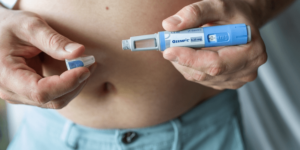Many of us struggle with losing weight and building muscle, despite doing everything right. There is nothing more frustrating than not seeing any return from our efforts. As we get older, it becomes even more difficult and often we look for help from potentially unsafe fad diets, extreme exercise programs and even anabolic steroids.
Something that seems to offer some hope with our fat loss and muscle gaining efforts, and appears to be safe and effective, are peptides. Studies have found that these small protein sequences can stimulate our body’s natural production of growth hormone, which can lead to decreased body fat and increased muscle mass, along with other potential benefits.
In this post, we will see what peptides are, how they work, what ones can be used for fat loss and for muscle mass, how they are administered, possible side effects, how to minimise them and other considerations.

Types of Peptides
Peptides are simply small chains of amino acids. Amino acids are the building blocks of all proteins, so essentially peptides are proteins usually made up of less than 50 amino acids. They can be found naturally in the body and are involved in a variety of physiological functions:
- Hormonal peptides: Regulate functions such as growth, metabolism, and reproduction.
- Neuropeptides: Function as neurotransmitters or neuromodulators in the nervous system, involved in pain regulation, appetite, and mood, for example.
- Antimicrobial peptides: These can kill or inhibit the growth of microorganisms such as bacteria and fungi.
- Enzymatic peptides: Are involved in metabolic reactions in the body.
- Ribosomal peptides: These are made by ribosomes in the command centres of our cells. They are often involved in protein synthesis and are important for the proper functioning of cells.
These are just a few examples of the many different types of peptides. Peptides have a wide range of functions and applications in the body and in various fields of research.
Peptides can be created in the laboratory for various purposes, and it is these types of synthetic peptides that can be used for medical treatments (e.g. semaglutide, the diabetes and weight loss medication) and sports performance enhancement.
How Peptides promote fat loss
To lose fat mass involves creating a calorie deficit by consuming fewer calories than the body burns, or increasing how many calories are expended. Peptides can be used to promote fat loss via different mechanisms, for example:
- Increasing your metabolic rate and energy expenditure, which can help burn more calories
- Stimulating lipolysis, the breakdown of stored fat, which can help reduce body fat
- Suppressing appetite and reducing food intake, which can reduce the risk of overeating.
- Enhancing insulin sensitivity and glucose metabolism, which can help reduce body fat and improve metabolic health.
Examples of Peptides for fat loss
In a recent post, the synthetic peptide GLP-1 semaglutide was discussed, which is an example of a peptide that can be used for fat loss. This works through multiple mechanisms such as suppressing appetite, increasing insulin sensitivity in muscles, and enhancing the breakdown of fat for energy.
There are several other peptides that have been studied for their potential to promote fat loss. Here are some of the most commonly studied peptides:
Growth hormone-releasing peptides (GHRPs), such as Ipamorelin, have been shown to increase metabolic rate and energy expenditure, which can help burn more calories and promote fat loss.
Melanotan II is a peptide that stimulates melanogenesis, or the production of melanin, in the skin. It can be used to develop tanned skin, boost natural protection against UV radiation and can even improve erection dysfunction. It can also stimulate lipolysis which can help reduce body fat.
AOD9604 is a peptide that is derived from the growth hormone-releasing hormone (GHRH) molecule. It can stimulate lipolysis and reduce body fat, particularly in the abdominal area.
Peptide YY (PYY) is a hormone that is produced in the gut in response to food intake. It can help suppress appetite and reduce food intake.
Ghrelin is a hormone that is produced in the stomach and plays a role in regulating hunger and energy balance. Synthetic ghrelin, such as tesamorelin and capromorelin, can help suppress appetite and reduce food intake.
It is important to note that the use of these peptides for fat loss is still a subject of ongoing research and clinical trials.

Dosage and administration of peptides for fat loss
Ipamorelin is a common peptide that has been the subject of numerous studies and is a popular choice amongst athletes, bodybuilders and anti-ageing enthusiasts.
It is a synthetic peptide that binds to the ghrelin receptor in the pituitary gland which stimulates the release of growth hormone (GH) from the pituitary gland. GH promotes the synthesis and release of Insulin-like Growth Factor-1 (IGF-1) from the liver and other tissues. Both GH and IGF-1 can stimulate lipolysis in fat tissue and promote muscle growth.
Ipamorelin has also been found to have several anti-ageing effects such as improved skin appearance, increased bone density, improved cognitive function, enhanced immune system and improved overall energy.
It is considered to be relatively safe and well-tolerated, with few reported side effects. Also, because it can stimulate GH release without affecting other hormones in the body, it is a more appealing option than other GH-releasing products that have more widespread effects.
Dosing
The recommended dosage of ipamorelin is typically 200-300 micrograms. The frequency depends on your goals, but commonly it is administered once per day, about 2 hours after the last meal of the day and before bed. This is aligned with your body’s natural rhythm of GH release.
Administration
Ipamorelin is typically administered via subcutaneous injection. It should be injected into the fatty tissue under the skin, such as the abdomen, thigh, or upper arm. The injection site should be rotated to avoid irritation and scarring.
Cycling
A course of ipamorelin should last somewhere between 60 to 90 days. It is recommended that there is at least a month’s break before repeating the cycle to minimise the risk of desensitisation.
How peptides promote muscle growth
Building muscle involves a complex interplay of different processes, including mechanical tension, metabolic stress, muscle damage, protein synthesis, and hormonal regulation. Peptides can help with these efforts through several mechanisms:
- Some peptides can help to promote muscle repair and reduce muscle damage, which can support more frequent and intense workouts without overtraining or injury.
- They can increase blood flow which improves the delivery of nutrients to muscles.
- Some peptides also have an anti-inflammatory effect, which is important in the context of chronic inflammation that can interfere with muscle growth.
- Protein synthesis can be increased to promote muscle growth using peptides. They can also reduce muscle breakdown, helping to preserve muscle mass.
- Other peptides can play a role in regulating hormones such as testosterone and growth hormone, which are important for muscle growth and repair.
Examples of Peptides for muscle mass
Here are some examples of peptides that have been studied for their potential effects on muscle mass:
GHRPs, like CJC-1295 and GHRP-6, stimulate the release of growth hormone (GH) and increase insulin-like growth factor-1 (IGF-1) levels in the body, which can support muscle growth.
The peptide BPC-157 has been shown to have potential healing effects on muscle and other tissues, which may promote muscle growth and recovery after exercise. It works by promoting the production of growth factors and other molecules that support tissue repair and regeneration. It also has anti-inflammatory effects that may help to reduce inflammation and promote healing.
TB-500 is also known for its healing effects on muscle tissue, as well as muscle growth and recovery after exercise. TB-500 works by promoting the production of proteins that support tissue repair and regeneration. It has been shown to stimulate the growth of new blood vessels and improve blood flow to damaged tissues. It also promotes the production of collagen, which is an important structural protein in muscles, tendons, and other tissues.
HGH Frag 176-191 peptide is a fragment of human growth hormone (HGH) that has been studied for its potential effects on fat loss and muscle growth. It stimulates the effects of HGH, having positive effects on muscle growth, without the potential negative effects on blood sugar levels that can occur with full HGH replacement therapy.
A peptide called ACE-031 works by blocking the activity of myostatin, which is a protein that inhibits muscle growth. By blocking myostatin, ACE-031 may help to promote muscle growth and improve muscle strength. It has been studied for its potential therapeutic uses in treating muscle-wasting conditions such as muscular dystrophy.

Dosage and administration of Peptides for muscle mass
CJC-1295 is a synthetic peptide hormone that has been shown to stimulate growth hormone release and promote fat loss and muscle gain. It has been used in many studies and is also a popular choice of peptide for many looking to gain or preserve muscle.
CJC-1295, like ipamorelin, acts at the pituitary gland but instead binds to growth hormone-releasing hormone (GHRH) receptors to stimulate the release of GH. This in turn causes the synthesis and release of IGF-1 from the liver and other tissues. Both GH and IGF-1 can stimulate lipolysis in fat tissue and promote muscle growth. It also has similar anti-ageing effects as ipamorelin does.
The effects of CJC-1295 on GH release are dose-dependent, meaning that higher doses can lead to greater GH release and potentially more pronounced effects.
It is considered to be relatively safe when used appropriately and under the guidance of a qualified healthcare provider.
Dosing
The dose and frequency of CJC-1295 can vary from 100-1000 micrograms and from daily to weekly injections, depending on the goal. However, the usual starting dose is 100 micrograms once daily before bed, with a total weekly dose eventually reaching anywhere between 1000-2000 micrograms. It is important to start with a lower dose and gradually increase over time to assess tolerance and effectiveness.
Administration
CJC-1295, like many peptides, is usually administered via subcutaneous injection into fatty tissue such as the abdomen, thigh or upper arm. The injection site should be rotated to avoid irritation and scarring.
Cycling
It is recommended to cycle the use of CJC-1295 to avoid desensitisation or other negative effects. A common cycle for CJC-1295 is 90 days of use, followed by a break of several weeks to several months before resuming use.
As with the use of any peptide, it is important to be under the guidance of a qualified healthcare provider or sports medicine specialist, to minimise risks and side effects, and to monitor your health and response to the treatment.
Common side effects of Peptides
As with any medication or supplement, there is always potential for side effects and peptides are no different. The specific side effects may vary depending on the type of peptide used, the dosage and administration, and the individual’s response to treatment. Some common side effects of peptides are:
- Injection site reactions such as redness, swelling, or pain.
- Headaches, particularly at higher dosages.
- Dizziness or lightheadedness
- Changes in blood pressure, either increases or decreases
- Gastrointestinal side effects such as nausea and vomiting.
- Water retention, particularly in those peptides that increase GH release
- Potentially increased risk of certain cancers from overuse of peptides that stimulate GH release

How to minimize side effects of Peptides
While peptides are generally considered safe and well-tolerated when used appropriately, there are steps that can be taken to minimize the risk of potential side effects.
- Work with a qualified healthcare professional who can provide guidance on the appropriate use of peptides
- Follow dosing and administration instructions provided
- Monitor for side effects and seek guidance from your healthcare provider as soon as they occur
- Ensure that the peptides being used are of high quality to minimize the risk of contamination or impurities.
- Depending on the type of peptide being used, cycling or tapering the dosage may help minimize the risk of side effects, particularly if used for extended periods of time.
Legal status of Peptides
Peptides can be prescribed legally in many countries, including the United States, Canada, Australia, and many European countries. However, the legality of peptides can vary depending on the specific peptide and its intended use.
In the UK some peptides are not approved for human use by the Medicines and Healthcare Products Regulatory Agency (MHRA). This means that they are not legal for human use, and any use of these peptides for performance enhancement or other non-medical purposes is considered to be illegal.
Unlock the Potential of Peptides for Fat Loss and Muscle Growth
In conclusion, peptides offer a promising solution for individuals struggling with fat loss and muscle building. These small protein sequences have been shown to stimulate the body’s natural production of growth hormone, leading to decreased body fat and increased muscle mass, among other potential benefits.
However, it is crucial to work with a qualified healthcare professional to ensure the safe and effective use of peptides. By following dosing and administration instructions, monitoring for side effects, and ensuring high-quality peptides, individuals can minimize risks and achieve the desired benefits.
If you’re considering using peptides for your fitness or health goals, make sure to seek guidance from a qualified professional.




